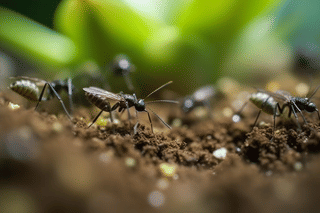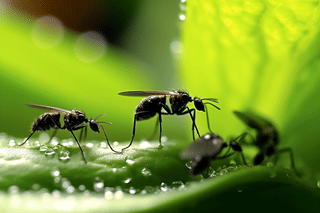How to Get Rid of Fungus Gnats on Houseplants
Keep your houseplants healthy and free of pesky fungus gnats with this step-by-step guide. Learn how to identify, treat, and prevent these common pests from taking over your home. Easy-to-follow tips and tricks for plant care beginners.

Are you having trouble with fungus gnats on your houseplants? It's a common problem, and it can be quite frustrating. Fortunately, if you're experiencing an outbreak of fungus gnats in your home, then I have some great tips for you!
In this plant care guide, I'll provide helpful information about what causes fungus gnats to infest houseplants and how to get rid of them effectively. I'll also give some tips on preventing future outbreaks so that you can enjoy growing your plants without worrying about these little insects taking over!
These are the topics we're going to look at in this plant care guide:
Let's get started and learn how we can get rid of this pest on your houseplants!
How do you differentiate between fungus gnats and other types of insects?
Do you notice tiny black flies, hovering around your plants? These could be fungus gnats! It's important to get familiar with what they look like and how they behave so that you can recognize them if they show up around your plants.
Fungus gnats look like small and delicate flies, with long legs and wings. They usually stick close to plants, where they lay their eggs in damp soil. After the eggs hatch, their larvae emerge which feed off the organic matter of your plants, draining them of their nutrients and disrupting their growth.
If you spot these adult flies buzzing around your plant, look down at the soil for any white egg deposits or tiny, wriggly worms. In that case, your plant has likely been taken over by fungus gnats.
How do you get fungus gnats?
Now that you can recognize fungus gnats, let's find out why they show up in the first place. Fungus gnats are linked with overwatered plants because their larvae feed on the organic matter found in the soil.
The wet, overwatered, soil is a fantastic breeding ground for the fungus gnats and feeds the larvae after they hatch. So if you consistently overwater your plants, you risk attracting fungus gnats to the soil of your plants.
How do fungus gnats harm the houseplants?
So fungus gnats are attracted to wet soil, but how do they harm your houseplants? Well, they don't directly harm your plant like most other pests. Like the whitefly, the adult flies don't harm your plants, but their larvae do. The larvae feed on your plant's roots and the organic matter in the soil.
Your plant needs this organic matter to feed itself as well, so fungus gnats are stealing the nutrients your plant needs to stay healthy. The larvae also slow down or stop the growth of the plant because of this feeding.
How do you prevent fungus gnats?
Preventing pests on your houseplants is an essential aspect of plant care, and it's no different when it comes to fungus gnats. Preventing pests from getting to your plants is the best way to keep them healthy long-term.
But how do you prevent getting fungus gnats on your plants? Here are some tips to prevent an infestation:
-
Use high-quality soil: Use soil that is well-draining and doesn't retain too much moisture. Fungus gnats are attracted to wet soil, so using soil that dries out quickly will prevent them from breeding.
-
Water your plants properly: Overwatering your plants can create a breeding ground for fungus gnats. Always check the top inch of soil before watering and avoid watering too frequently.
-
Maintain good hygiene: Remove any debris, dead leaves, or decaying organic matter from the soil's surface. Fungus gnats thrive in moist, organic matter, and removing it will reduce the chances of an infestation.
-
Use sticky traps: Yellow sticky traps are useful for trapping adult fungus gnats. Place them near your plants to catch and monitor the flies. This way they don't get the chance to lay their eggs.
How do you get rid of fungus gnats?
Spot any fungus gnats hanging out near your houseplants? You don't want to wait and risk an infestation: take action quickly to prevent the pest from getting out of control! Getting rid of them in their early stages will help save both you and your plants, a lot of hassle in the long run.
Here are the steps to get rid of fungus gnats:
-
Let the soil dry out: Fungus gnats thrive in damp soil, so allow the soil to dry out slightly before watering next. The drying-out period will stop the larvae from breeding, and they will eventually die.
-
Use natural enemies: Natural enemies of the fungus gnats, such as Bacillus thuringiensis, are very effective in controlling fungus gnats. These bacteria produce toxins that kill the larvae in the soil, preventing them from growing into adult flies.
-
Use sticky traps: Place sticky traps near your plants to catch adult fungus gnats. These traps will not only capture adult flies but also reduce their population by interrupting their breeding cycle.
-
Repot your plants: If all else fails, you can always repot your plants in fresh, clean soil. Make sure the new soil is well-draining and allows for proper airflow to keep your plants healthy and prevent fungus gnats from laying eggs again.
Conclusion
Fungus gnats are a common problem for houseplants, but with a few preventative measures and quick action, it's easy to get rid of them. Always use high-quality soil, water your plants properly, and maintain good hygiene to prevent a fungus gnat infestation.
If you notice fungus gnats, allow the soil to dry out, use a biological control agent, place sticky traps, and repot your plants if necessary. By following these steps, you can keep your houseplants healthy and thriving, free from fungus gnats.
Thank you for reading this post! I hope it helps you to keep your plants healthy and beautiful! If you're looking for more guides on specific plants, you can always request a plant guide to get a guide for the plant you have trouble with.
Test your plant care knowledge
Quiz completed!
Want to learn more? Sign up for my newsletter to receive free tips in your inbox!
Sign up now!









